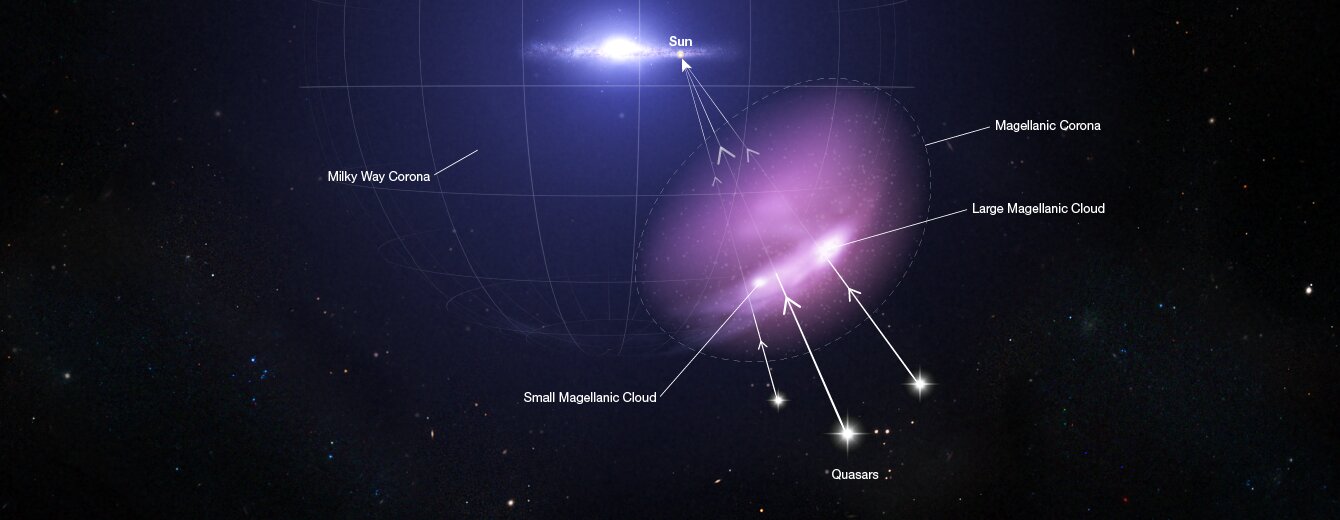Photo credit: NASA
For billions of years, the Milky Way’s largest satellite galaxies – the Large and Small Magellanic Clouds – have followed a perilous journey. Orbiting each other as they are being pulled toward our home galaxy, they have begun to disintegrate, leaving trails of gaseous debris. And yet – to the amazement of astronomers – these dwarf galaxies remain intact, with ongoing vigorous star formation.
“A lot of people struggled to explain how these streams of material could be there,” said Dhanesh Krishnarao, an assistant professor at Colorado College. “If that gas was removed from these galaxies, how do they still form stars?”
Using data from NASA’s Hubble Space Telescope and a decommissioned satellite called the Far Ultraviolet Spectroscopic Explorer (FUSE), a team of astronomers led by Krishnarao has finally found the answer: the Magellanic system is surrounded by a corona, a protective shield from hot charged gas. This will shroud the two galaxies, preventing their gas supplies from being tapped from the Milky Way and thus allowing them to continue forming new stars.
This discovery just published in Nature, deals with a new aspect of galaxy evolution. “Galaxies envelop themselves in gaseous cocoons that act as defensive shields against other galaxies,” said co-researcher Andrew Fox of the Space Telescope Science Institute in Baltimore, Maryland.
Astronomers predicted the existence of the corona a few years ago. “We discovered that if we included a corona in the simulations of the Magellanic Clouds’ incursion into the Milky Way, we could, for the first time, explain the mass of the extracted gas,” explained Elena D’Onghia, a fellow researcher at the University of Wisconsin- madison “We knew that the Large Magellanic Cloud should be massive enough to have a corona.”
But despite stretching more than 100,000 light-years from the Magellanic Clouds and covering much of the southern sky, the corona is virtually invisible. To map it, 30 years of archived data had to be scoured for suitable measurements.
Researchers believe that a galaxy’s corona is a remnant of the original gas cloud that collapsed billions of years ago to form the galaxy. Although coronas have been seen around more distant dwarf galaxies, astronomers have never been able to study one in as much detail as this one.
“There are many predictions from computer simulations of what they should look like, how they should interact over billions of years, but we can’t really test most of them because dwarf galaxies are usually just too difficult to detect,” he said. Being right on our doorstep, the Magellanic Clouds provide an ideal opportunity to study how dwarf galaxies interact and evolve.
Looking for direct evidence of the Magellanic corona, the team combed the Hubble and FUSE archives for UV observations of quasars billions of light-years beyond. Quasars are the extremely bright nuclei of galaxies that host massive active black holes. The team reasoned that although the corona would be too dim to see on its own, it should be visible as a kind of nebula, obscuring and absorbing distinct patterns of bright light from quasars in the background. Hubble observations of quasars have historically been used to map the corona around the Andromeda galaxy.
By analyzing patterns in the ultraviolet light from 28 quasars, the team was able to identify and characterize the material surrounding the Large Magellanic Cloud and confirm that the corona exists. As predicted, the quasar spectra are marked with the distinct signatures of carbon, oxygen, and silicon that form the halo of hot plasma that surrounds the galaxy.
The ability to see the corona required extremely detailed ultraviolet spectra. “The resolution of Hubble and FUSE was critical to this study,” explained Krishnarao. “The corona gas is so diffuse, it’s hardly there.” In addition, it is mixed with other gases, including streams drawn from the Magellanic Clouds and material originating from the Milky Way.
By mapping the results, the team also discovered that the amount of gas decreases with distance from the center of the Large Magellanic Cloud. “It’s a perfect tell-tale signature that this corona is really there,” Krishnarao said. “It really envelops and protects the galaxy.”
How can such a thin shell of gas protect a galaxy from destruction?
“Anything trying to enter the galaxy has to pass through that material first so it can absorb some of that impact,” Krishnarao explained. “Also, the corona is the first material that can be extracted. While giving up a little corona, you protect the gas that resides in the galaxy itself and can form new stars.”
Magellanic Stream circling above the Milky Way could be five times closer than previously thought
Dhanesh Krishnarao et al, Observations of a Magellanic Corona, Nature (2022). DOI: 10.1038/s41586-022-05090-5
Citation: Hubble Spots Shield Defending Two Dwarf Galaxies (2022 September 28) Retrieved September 29, 2022 from https://phys.org/news/2022-09-hubble-shield-defending-pair-dwarf.html
This document is protected by copyright. Except for fair trade for the purpose of private study or research, no part may be reproduced without written permission. The content is for informational purposes only.
#Hubble #discovers #protective #shield #defending #pair #dwarf #galaxies


Leave a Comment